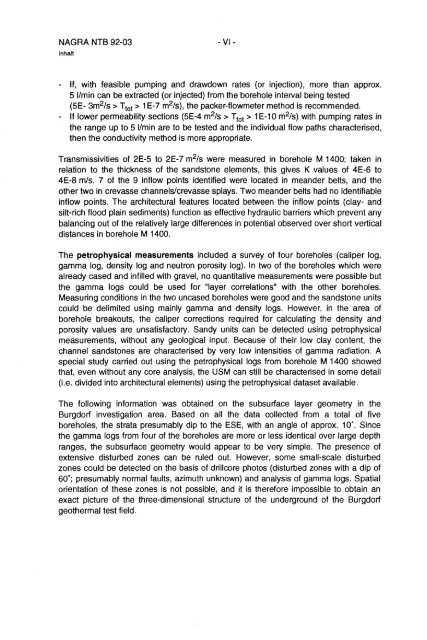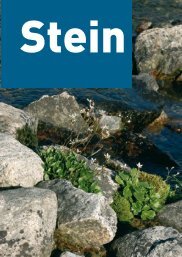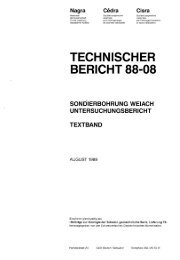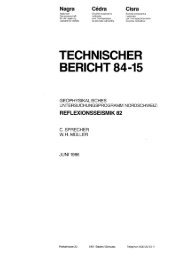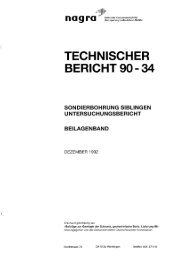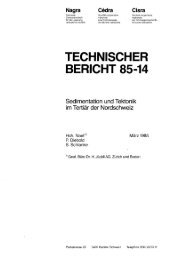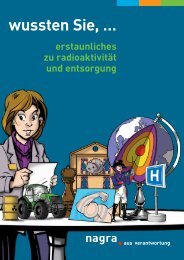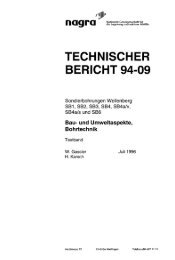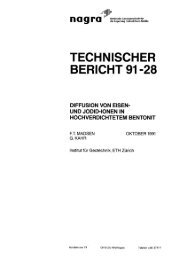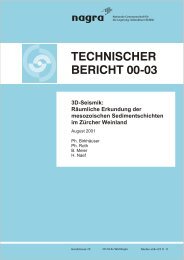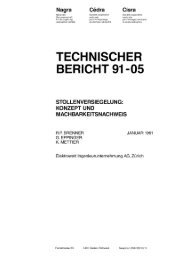Deutsch (9.3 MB) - Nagra
Deutsch (9.3 MB) - Nagra
Deutsch (9.3 MB) - Nagra
Erfolgreiche ePaper selbst erstellen
Machen Sie aus Ihren PDF Publikationen ein blätterbares Flipbook mit unserer einzigartigen Google optimierten e-Paper Software.
NAGRA NTB 92-03<br />
Inhalt<br />
- VI -<br />
- If, with feasible pumping and drawdown rates (or injection), more than approx.<br />
S I/min can be extracted (or injected) from the borehole inteNal being tested<br />
(SE- 3m2/s > T tot > 1 E-7 m2/s) , the packer-flowmeter method is recommended.<br />
- If lower permeability sections (SE-4 m 2 /s > T tot > 1 E-1 0 m2/s) with pumping rates in<br />
the range up to S I/min are to be tested and the individual flow paths characterised,<br />
then the conductivity method is more appropriate.<br />
Transmissivities of 2E-S to 2E-7 m 2 /s were measured in borehole M 1400; taken in<br />
relation to the thickness of the sandstone elements, this gives K values of 4E-6 to<br />
4E-8 m/s. 7 of the 9 inflow paints identified were located in meander belts, and the<br />
other two in crevasse channels/crevasse splays. Two meander belts had no identifiable<br />
inflow points. The architectural features located between the inflow points (clay- and<br />
silt-rich flood plain sediments) function as effective hydraulic barriers which prevent any<br />
balancing out of the relatively large differences in· potential obseNed over short vertical<br />
distances in borehole M 1400.<br />
The petrophysical measurements included a sUNey of four boreholes (caliper log,<br />
gamma log, density log and neutron porosity log). In two of the boreholes which were<br />
already cased and infilled with gravel, no quantitative measurements were possible but<br />
the gamma logs could be used for "layer correlations" with the other boreholes.<br />
Measuring conditions in the two uncased boreholes were good and the sandstone units<br />
could be delimited using mainly gamma and density logs. However, in the area of<br />
borehole breakouts, the caliper corrections required for calculating the density and<br />
porosity values are unsatisfactory. Sandy units can be detected using petrophysical<br />
measurements, without any geological input. Because of their low clay content, the<br />
channel sandstones are characterised by very low intensities of gamma radiation. A<br />
special study carried out using the petrophysical logs from borehole M 1400 showed<br />
that, even without any core analYSis, the USM can still be characterised in some detail<br />
(Le. divided into architectural elements) using the petrophysical dataset available.<br />
The following information was obtained on the subsurface layer geometry in the<br />
Burgdorf investigation area. Based on all the data collected from a total of five<br />
boreholes, the strata presumably dip to the ESE, with an angle of approx. 10°. Since<br />
the gamma logs from four of the boreholes are more or less identical over large depth<br />
ranges, the subsurface geometry would appear to be very simple. The presence of<br />
extensive distu rbed zones can be ruled out. However, some small-scale distu rbed<br />
zones could be detected on the basis of drillcore photos (disturbed zones with a dip of<br />
60°; presumably normal faults, azimuth unknown) and analysis of gamma logs. Spatial<br />
orientation of these zones is not possible, and it is therefore impossible to obtain an<br />
exact picture of the three-dimensional structure of the underground of the Burgdorf<br />
geothermal test field.


